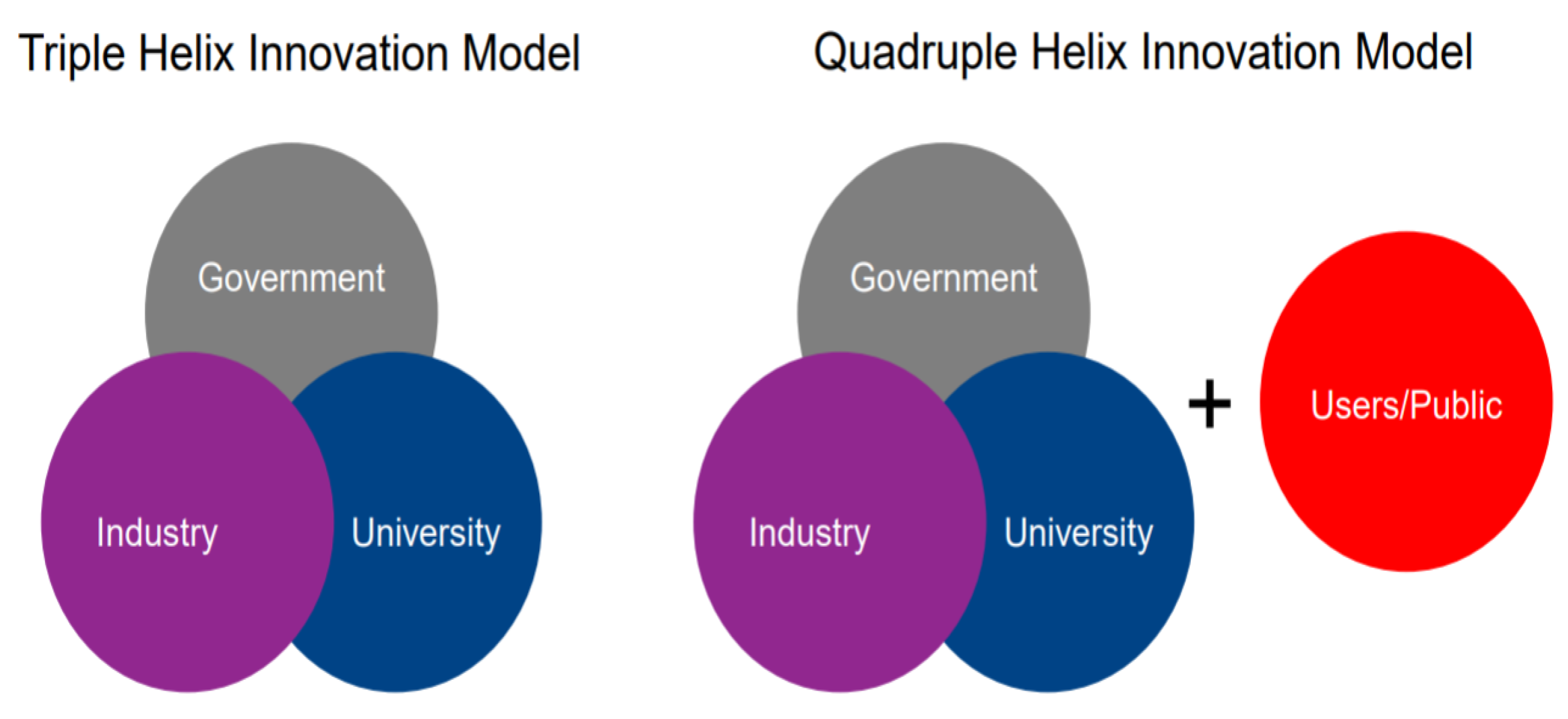Living Labs in University-Industry Cooperation as a Part of Innovation Ecosystem: Case Study of South Korea
Abstract
:1. Introduction
- First, each case tends to link science technology and information and communication technology with local problem solving, though there is a difference between the technologies used.
- Second, local residents play a leading role in the whole living lab process from problem identification to technical experimentation, diffusion, and application.
- Third, intermediaries commonly play an important role in the operation of living labs.
- The problem recognized in the Korean innovation system is how to improve some advanced skills and elements of them (for example, flexibility, adaptability, and creativity), which is helpful for current crisis overlap within economic development.
- The ecosystem description was used some time ago to suggest that market participants are not just competing, but rather motivated to seek the benefits of sharing resources, networks, transfers, and ideas. By bringing together market participants such as companies, business incubators, and industrial clusters, they seek to create synergies that enhance the innovation environment.
- Start-up incubators drive market demand by focusing on the needs of tech entrepreneurs. Some incubators operate as autonomous ecosystems, but often the creation of an infrastructure, that is, a city, a region, or even an entire country, is required to effectively create an innovation ecosystem [8].
- They lack its own capability to plan products and services that reflect target markets and customer needs on its own.
- Compared to big companies, it is difficult to gain consumer confidence and improve satisfaction because the accumulation of data on consumer experience is insufficient.
- Even after product and service development, it is difficult to obtain certification, so there are many cases of failure to market.
2. Literature Review
2.1. Innovative Ecosystem Features
- Purposeful process: an innovation ecosystem is built around a process of commercialization of innovations, which has a clear result in the form of the output of products on market.
- Subjects interact in the process of commercialization of innovation.
- There are connections between them.
- There is an environment that provides resources for the subjects of commercialization of innovation.
- Commercial results in the form of transactions in three main forms: customization, research and development, and intellectual property rights (licensing).
- A consistent, unbreakable transformation of an idea into a deal: a stream of input ideas, developments, and competencies of team members, converted into assets that are then sold. It is important to understand that the ideas themselves and the teams are not assets. Thus, resources can be sold on the market only when they have passed the stage of transformation into commercial projects with specific assets [14,15].
- The subjects are relevant specialists united in interaction networks, thereby ensuring continuity in the process of commercializing innovations.
- A suitable environment for commercialization. Such an environment could do the following:
- Stimulate active interactions with subjects of the commercialization process by promoting innovations, forming networks of interaction, and holding events.
- Use formal (laws, regulations) and informal (culture) institutions to stimulate the commercialization of innovations and minimize possible losses arising when interacting with the environment.
- Have sufficient financial and infrastructural resources to organize the process of innovation commercialization.
2.2. University–Industry Cooperation and Its Impact on Living Lab
- Joint R&D projects between industry and universities
- Specialized training programs carried out by universities for enterprises (mainly in new or rapidly developing areas)
- A wide range of activities carried out within the framework of so-called complex agreements between universities and enterprises. In this case, tasks related to both the targeted training of specialists for the enterprise and the solution of engineering and technological problems by the joint efforts of both parties are solved simultaneously.
- A range of consulting services provided by university staff for industrial companies.
- Innovation, start-ups, and individual jobs carried out for industrial enterprises through university incubators and technology parks.
2.3. Role of Living Labs in Innovation Ecosystem
- Research type to support large-scale demonstration projects in new industries and for business model commercialization.
- Non-exploratory type at the city and provincial level to support the creation of associations.
3. Research Questions and Methodology
3.1. Research Goals and Limitations
- In order to expand Living Lab, its focus should not only be restricted to abstract discussion but also cover real-life related subjects such as current local issues or local economics as well as new technology, product or service which will eventually support everyday life of local residents or consumers. In this critical perspective, Living Lab execution model should be established that deals with practical and detailed life issues such as safety, residence, traffic, environment or health [40,41].
- Kim in 2015 [41] reported that over the past decade, living labs have become an established part of local and regional innovation systems using a variety of methods and tools and focusing on a wide array of domains and themes. However, the experimental, learning-by-doing setup of living labs within various application domains in Korea and the lack of connection between living labs have led to a wide variation of approaches, results, and impacts. Furthermore, the economic logic and business model of living labs remain underdeveloped in the Korean market [42,43]. Therefore, as this innovation instrument matures, it is crucial to ensure that its main strength in terms of local embeddedness does not turn into a significant weakness in terms of the general applicability, validity, and robustness of living lab test results. Based on this evidence, the authors conclude that there is a need for an analytical approach enabling case-by-case customization of the collaboration model for every innovative product, service, or business model [44].
- How can an innovation system be developed with living laboratories?
- How do living laboratories focus on start-up project development?
- Could university–industry cooperation improves the innovation ecosystem using living labs?
3.2. Research Methods
4. Survey and Results
- Resource management is an important element of living lab;
- Technology affects infrastructure and start-up development;
- Innovation ecosystem needs to be improved;
- Innovation ecosystem can be developed without living lab activities;
- Living lab needs support from government, etc.
5. Discussion
6. Conclusions
- How can an innovation system be developed with living laboratories?
- How do living laboratories focus on start-up project development?
- Could university–industry cooperation improves the innovation ecosystem using living labs?
Author Contributions
Funding
Institutional Review Board Statement
Informed Consent Statement
Data Availability Statement
Conflicts of Interest
Appendix A
| Statement | 1 Strongly Disagree | 2 | 3 | 4 | 5 | 6 | 7 | 8 | 9 | 10 Strongly Agree |
|---|---|---|---|---|---|---|---|---|---|---|
| 1 Living lab has strong positive impact on innovation ecosystem development | ||||||||||
| 2 Living lab needs support from government | ||||||||||
| 3 Innovation ecosystem needs to be improved | ||||||||||
| 4 Resource management is an important element of living lab | ||||||||||
| 5 Organizational management is an important part of living lab | ||||||||||
| 6 Financial sources of innovation ecosystem have impact on living lab life cycle | ||||||||||
| 7 Technology affects infrastructure and start-up development | ||||||||||
| 8 Legal regulations and standards are not important for living labs | ||||||||||
| 9 Human capital does not have strong impact on living lab process | ||||||||||
| 10 Innovation ecosystems can be developed without living lab activities |
| Statement | 1 Strongly Disagree | 2 | 3 | 4 | 5 | 6 | 7 | 8 | 9 | 10 Strongly Agree |
|---|---|---|---|---|---|---|---|---|---|---|
| 1 Living lab has strong positive impact on innovation ecosystem development | 0 | 0 | 1 | 2 | 2 | 7 | 5 | 5 | 5 | 3 |
| 2 Living lab needs support from government | 0 | 0 | 0 | 3 | 3 | 7 | 6 | 4 | 5 | 2 |
| 3 Innovation ecosystem needs to be improved | 1 | 2 | 2 | 2 | 1 | 5 | 4 | 4 | 4 | 6 |
| 4 Resource management is an important element of living labs | 1 | 0 | 1 | 5 | 3 | 5 | 3 | 4 | 5 | 3 |
| 5 Organizational management is an important part of living labs | 0 | 1 | 2 | 5 | 4 | 3 | 6 | 5 | 0 | 3 |
| 6 Financial sources of innovation ecosystem have impact on living lab life cycle | 0 | 2 | 0 | 5 | 5 | 5 | 7 | 1 | 2 | 3 |
| 7 Technology affects infrastructure and start-up development | 1 | 2 | 3 | 2 | 4 | 4 | 3 | 5 | 3 | 3 |
| 8 Legal regulations and standards are not important for living labs | 5 | 3 | 2 | 5 | 1 | 6 | 4 | 2 | 1 | 1 |
| 9 Human capital does not have strong impact on living lab process | 4 | 4 | 2 | 6 | 4 | 5 | 3 | 1 | 0 | 1 |
| 10 Innovation ecosystems can be developed without living lab activities | 6 | 5 | 4 | 5 | 4 | 1 | 1 | 2 | 0 | 2 |
| Statement | 1 Strongly Disagree | 2 | 3 | 4 | 5 | 6 | 7 | 8 | 9 | 10 Strongly Agree |
|---|---|---|---|---|---|---|---|---|---|---|
| 1 Living lab has strong positive impact on innovation ecosystem development | 0 | 0 | 1 | 1 | 1 | 7 | 7 | 5 | 5 | 3 |
| 2 Living lab needs support from government | 0 | 0 | 0 | 1 | 3 | 7 | 6 | 4 | 5 | 4 |
| 3 Innovation ecosystem needs to be improved | 1 | 0 | 0 | 2 | 3 | 5 | 6 | 4 | 4 | 6 |
| 4 Resource management is an important element of living labs | 0 | 0 | 0 | 5 | 3 | 5 | 5 | 4 | 5 | 3 |
| 5 Organizational management is an important part of living labs | 0 | 1 | 1 | 3 | 4 | 4 | 6 | 5 | 2 | 3 |
| 6 Financial sources of innovation ecosystem have impact on living lab life cycle | 0 | 0 | 0 | 5 | 5 | 5 | 7 | 3 | 2 | 3 |
| 7 Technology affects infrastructure and start-up development | 1 | 0 | 0 | 2 | 4 | 4 | 3 | 5 | 6 | 5 |
| 8 Legal regulations and standards are not important for living labs | 7 | 3 | 2 | 5 | 1 | 6 | 2 | 2 | 1 | 1 |
| 9 Human capital does not have strong impact on Living lab process | 6 | 4 | 2 | 6 | 4 | 5 | 2 | 1 | 0 | 0 |
| 10 Innovation ecosystems may be developed without living lab activities | 8 | 5 | 4 | 5 | 4 | 0 | 0 | 2 | 2 | 0 |
| Statement | 1 Strongly Disagree Phase 2 | 1 Strongly Disagree Phase 1 | 10 Strongly Agree Phase 2 | 10 Strongly Agree Phase 1 |
|---|---|---|---|---|
| 1 Living lab has strong positive impact on innovation ecosystem development | 0 | 0 | 3 | 3 |
| 2 Living lab needs support from government | 0 | 0 | 4 | 2 |
| 3 Innovation ecosystem needs to be improved | 1 | 1 | 6 | 6 |
| 4 Resource management is an important element of living labs | 0 | 1 | 3 | 3 |
| 5 Organizational management is an important part of living labs | 0 | 0 | 3 | 3 |
| 6 Financial sources of innovation ecosystem have impact on living lab life cycle | 0 | 0 | 3 | 3 |
| 7 Technology affects infrastructure and start-up development | 1 | 1 | 5 | 3 |
| 8 Legal regulations and standards are not important for living labs | 7 | 5 | 1 | 1 |
| 9 Human capital does not have strong impact on Living lab process | 6 | 4 | 0 | 1 |
| 10 Innovation ecosystems may be developed without living lab activities | 8 | 6 | 0 | 2 |
References
- Lee, S.; Lee, H.; Lee, C. Open innovation at the national level: Towards a global innovation system. Technol. Forecast. Soc. Chang. 2020, 151, 119842. [Google Scholar] [CrossRef]
- Sung, C. Innovation, Competitiveness, and Growth: Korean Experiences. Annual World Bank Conference on Development Economics, Global, The International Bank for Reconstruction and Development, The World Bank. 2020, pp. 337–340. Available online: http://www.rrojasdatabank.info/wbdevecon10-22.pdf (accessed on 23 October 2020).
- Geiger, R.; Sá, C. Tapping the Riches of Science: Universities and the Promise of Economic Growth; Harvard: Cambridge, MA, USA, 2013; pp. 378–409. [Google Scholar]
- Brynjolfsson, E.; McAfee, A. The Second Machine Age: Work, Progress and Prosperity in a Time of Brilliant Technologies; W.W. Norton & Company: New York, NY, USA, 2014; pp. 23–34. [Google Scholar]
- Taylor, S.; Hansen, H. Finding form: Looking at the field of organizational aesthetics. J. Manag. Stud. 2015, 42, 1211–1231. [Google Scholar] [CrossRef]
- Cresson, E. Towards a Knowledge-Based Europe; Lecture by Mrs. Edith Cresson at the London School of Economics and Political Science; European Commission: Brussels, Belgium, 2018; pp. 34–41. [Google Scholar]
- Kim, G. The concept of the third level for South Korea, Responsible innovation system. Policy Rev. 2018, 2, 23–48. [Google Scholar]
- Seong, J.; Han, K.; Jeong, S. A Case Study on Korean Living Labs for Local Problem-Solving. J. Sci. Technol. Stud. 2016, 16, 65–98. [Google Scholar]
- Global Innovation Index 2019. Available online: https://thegedi.org/ (accessed on 16 September 2020).
- Rothschild, M. Bionomics: Economy as Ecosystem; Henry Holt and Company: New York, NY, USA, 1990; pp. 67–123. [Google Scholar]
- Morrar, R.; Arman, H.; Mousa, S. The Fourth Industrial Revolution (Industry 4.0): A Social Innovation Perspective. Technol. Innov. Manag. Rev. 2017, 7, 12–20. [Google Scholar] [CrossRef] [Green Version]
- Buhr, D. Social Innovation Policy for Industry 4.0; Eberhard Karls University of Tübingen: Tübingen, Germany, 2017; pp. 45–121. [Google Scholar]
- Friesen, E. The World Economic Forum and Transnational Networking; Emerald Publishing Limited: Bingley, UK, 2020; pp. 133–161. [Google Scholar]
- Compagnucci, L.; Spigarelli, F.; Coelho, J.; Duarte, C. Living Labs and user engagement for innovation and sustainability. J. Clean. Prod. 2021, 289, 125–721. [Google Scholar] [CrossRef]
- Leminen, S.; Westerlund, M.; Nyström, A.; Kortelainen, M. The Effect of Network Structure on Radical Innovation in Living Labs. J. Bus. Ind. Mark 2016, 31, 743–757. [Google Scholar] [CrossRef]
- Schuurman, D.; Herregodts, A.-L.; Georges, A.; Rits, O. Innovation Management in Living Lab Projects: The Innovatrix Framework. Technol. Innov. Manag. Rev. 2019, 9, 63–73. [Google Scholar] [CrossRef]
- Wessner, C.W. Innovation Policies for the 21st Century; Report of a Symposium; The National Academies Press: Washington, DC, USA, 2015; pp. 34–39. [Google Scholar]
- Joel, R. Troy University/Building an IT Economy: South Korean Science and Technology Policy. Technology Innovation. 2018, Volume 19, pp. 1–9. Available online: https://www.brookings.edu/wp-content/uploads/2016/06/CTI_19-_Korea_Tech_Paper_Formatted.pdf (accessed on 12 December 2020).
- What Is a Living Lab? About Us, ENoLL. Available online: http://www.openlivinglabs.eu/aboutus (accessed on 22 November 2020).
- Leminen, S.; Westerlund, M.; Nyström, A. Living Labs as Open Innovation Networks. Technol. Innov. Manag. Rev. 2012, 9, 6–11. [Google Scholar] [CrossRef]
- Feurstein, K.; Hesmer, A.; Hribernik, K.A.; Thoben, K.D.; Schumacher, J. Living Labs: A new development strategy. In European Living Labs—A New Approach for Human Centric Regional Innovation; Wissenschaftlicher Verlag: Berlin, Germany, 2008; pp. 1–4. [Google Scholar]
- Baccarne, B.; Logghe, S.; Veeckman, C.; Schuurman, D. Why collaborate in long-term innovation research? An exploration of user motivations in Living Labs. In Proceedings of the 4th ENoLL Living Lab Summer School 2013, Manchester, UK, 27–30 August 2013; European Network of Living Labs: Brussels, Belgium, 2013. [Google Scholar]
- Leshakova, N. State regulation of innovative development of the Republic of Korea. Russ. J. Innov. Econ. 2017, 7, 161–174. [Google Scholar]
- Luppicini, R. Ethical Impact of Technological Advancements and Applications in Society; Information Science Reference: Hershey, PA, USA, 2018; pp. 3–12. [Google Scholar]
- Lee, C. Features of corporate governance and the role in the development of the national economy. Bull. Peoples’ Friendsh. Univ. Russ. Ser. Econ. 2019, 4, 27–37. (In Russian) [Google Scholar]
- Etzkowitz, H.; Leydesdorff, L. The dynamics of innovation: From national systems and ‘Mode 2’ to a triple helix of university-industry-government relations. Res Policy 2000, 29, 109–123. [Google Scholar] [CrossRef]
- Arnkil, R.; Järvensivu, A.; Koski, P.; Piirainen, T. Exploring Quadruple Helix. Outlining User-Oriented Innovation Models, Final Report on Quadruple Helix Research for the CLIQ Project, Tampere. 2016. Available online: http://uta32-kk.lib.helsinki.fi/bitstream/handle/10024/65758/978–951–44–8209–0.pdf?sequence=1 (accessed on 2 December 2020).
- Leydesdorff, L. The Knowledge-Based Economy and the Triple Helix Model. Annu. Rev. Inf. Sci. Technol. 2012, 44, 365–417. [Google Scholar] [CrossRef] [Green Version]
- Galvao, A.; Mascarenhas, C.; Marques, C.; Ferreira, J.; Ratten, V. Triple helix and its evolution: A systematic literature review. J. Sci. Technol. Policy Manag. 2019, 10, 812–833. [Google Scholar] [CrossRef]
- Etzkowitz, H.; Leydesdorff, L. The Triple Helix—University-Industry-Government Relations: A Laboratory for Knowledge Based Economic Development; SSRN: Rochester, NY, USA, 1995; SSRN 2480085. [Google Scholar]
- Etzkowitz, H.; Leydesdorff, L. The endless transition: A “Triple Helix” of university-industry-government relations, introduction to a theme issue. Minerva 1998, 36, 203–218. [Google Scholar] [CrossRef]
- Carayannis, E.; Campbell, D. Mode 3 and Quadruple Helix: Toward a 21st century fractal innovation ecosystem. Int. J. Technol. Manag. 2015, 46, 201–234. [Google Scholar] [CrossRef] [Green Version]
- The Triple Helix Concept; Stanford University Triple Helix Research Group: Stanford, CA, USA, 2017; pp. 45–67.
- Park, H.W. Transition from the Triple Helix to N-Tuple Helices? An interview with Elias G. Carayannis and David F. J. Campbell. Scientometrics 2014, 99, 203–207. [Google Scholar] [CrossRef] [Green Version]
- Kwon, K. Emergence of Research and Entrepreneurial Activities of Korean Universities. In Proceedings of the Conference on University-Industry Linkages and Economic Performance, Seoul, Korea, 27–29 February 2009. [Google Scholar]
- Lee, J. The Republic of Korea’s Economic Growth and Catch-Up: Implications for the People’s Republic of China. Working Paper Series ADBI. 2016. No. 571. pp. 28–30. Available online: https://www.adb.org/sites/default/files/publication/183353/adbiwp571.pdf (accessed on 1 November 2020).
- Han, J.; Kim, K. Enhancing Innovation Platform: Bitgaram Innocity Gwangju Using ICT in Korea. Asian Res. Policy 2015, 6, 13–26. [Google Scholar]
- Cho, E. Transforming a Neighborhood into a Living Laboratory for Ur-ban Social Innovation: A Com-parative Case Study of Urban Living Labs. In Cross-Cultural Design. Applications in Cultural Heritage, Creativity and Social Development; Springer: Cham, Switzerland, 2018. [Google Scholar] [CrossRef]
- Kim, Y.; Lee, H.; Lee, M.-K.; Lee, H.; Jang, H. Development of a Living Lab for a Mobile-Based Health Program for Korean-Chinese Working Women in South Korea: Mixed Methods Study. J. Med. Interdiscip. Res. 2020, 8, e15359. [Google Scholar] [CrossRef]
- Kim, J.; Moon, I. A Study on Smart Factory Construction Method for Efficient Production Management in Sewing Industry. J. lnf. Commun. Converg. 2020, 18, 61–68. [Google Scholar]
- Kim, E. The impact of family ownership and capital structures on productivity performance of Korean manufacturing firms: Corporate governance and the «chaebol problem». J. Jpn. Int. Econ. 2015, 20, 209–233. Available online: https://www.researchgate.net/publication/222672874_The_impact_of_family_ownership_and_capital_structures_on_productivity_performance_of_Korean_manufacturing_firms_Corporate_governance_and_the_chaebol_problem (accessed on 12 October 2020). [CrossRef]
- Frank, C.; Kim, K.; Westphal, L. Foreign Trade Regimes and Economic Development: South Korea; National Bureau of Economic Research: New York, NY, USA, 1995; pp. 23–45. [Google Scholar]
- Abatecola, G.; Mandarelli, G.; Poggesi, S. The personality factor: How top management teams make decisions. A literature review. J. Manag. Gov. 2013, 17, 1073–1100. [Google Scholar] [CrossRef]
- KoreaTechToday. Available online: https://www.koreatechtoday.com/tag/living-lab/ (accessed on 12 December 2020).
- Preuveneers, D.; Ilie-Zudor, E. The intelligent industry of the future: A survey on emerging trends, research challenges and opportunities in Industry 4.0. J. Ambient. Intell. Smart Environ. 2017, 9, 287–298. [Google Scholar] [CrossRef] [Green Version]
- Wise, E.; Høgenhaven, C. User-Driven Innovation, Context and Cases in the Nordic Region; Nordic Innovation Centre: Oslo, Norway, 2018; pp. 56–102. [Google Scholar]
- Schuh, G.; Potente, T.; Wesch-Potente, C.; Weber, A.; Prote, J. Collaboration Mechanisms to increase Productivity in the Context of Industrie 4.0. In Proceedings of the 19th Robust Manufacturing Conference (CIRP), Bremen, Germany, 7–9 July 2014; pp. 51–56. [Google Scholar]
- Mosconi, M. The New European Industrial Policy; Routledge: London, UK, 2015; ISBN 9781315761756. [Google Scholar]
- Buguin, J.; Dobbs, R.; Bisson, P.; Marrs, A. Disruptive Technologies: Advances that Will Transform Life, Business, and the Global Economy; McKinsey Global Institute: San Francisco, CA, USA, 2019; pp. 67–99. [Google Scholar]
- Guidelines for Living Labs in Climate Service, EU MACS. Available online: http://eu-macs.eu/ (accessed on 9 March 2019).
- Carayannis, E.; Campbell, D. Mode 3 Knowledge Production in Quadruple Helix Innovation Systems; Springer Briefs in Business; Springer: New York, NY, USA, 2016; pp. 5–9. [Google Scholar]
- Kolotyrina, E. Specific Features of Innovation System Formation of The Republic of Korea. Bull. Peoples’ Friendsh. Univ. Russ. Ser. Econ. 2019, 2, 96–105. (In Russian) [Google Scholar]
- Schuurman, D.; De Moor, K.; De Marez, L.; Evens, T. Living Lab research approach for mobile TV. Telemat. Inform. 2011, 28, 271–282. [Google Scholar] [CrossRef]
- Hubavem, G. Open Innovation 4.0, Digital Single Market; European Commission: Brussels, Belgium, 2019; pp. 56–78. [Google Scholar]
- Hossain, M.; Leminen, S.; Westerlund, M. A Systematic Review of Living Lab Literature. J. Clean. Prod. 2019, 213, 976–988. [Google Scholar] [CrossRef]
- Schuurman, D.; de Marez, L.; Ballon, P. Living Labs: A Systematic Literature Review. In Proceedings of the Open Living Lab Days, Istanbul, Turkey, 25–28 August 2015. [Google Scholar]
- Schwab, K. The Fourth Industrial Revolution; World Economic Forum: New York, NY, USA, 2014; pp. 34–52. [Google Scholar]
- Shvetsova, O. Technology learning in automobile industry: Comparative study between Korean and Thai Companies. Open Transp. J. 2019, 13, 236–249. [Google Scholar] [CrossRef]
- Rosted, J.; Lau, T.; Hogenhaven, C.; Johansen, P. Concept Design: How to Solve Complex Challenges of Our Time; Mc Afee: San Jose, CA, USA, 2017; pp. 67–108. [Google Scholar]
- Kim, M.; Kim, P.; Yoon, J. Living Lab as a Industrial Platform. Ind. Eng. Mag. 2020, 27, 38–45. [Google Scholar]
- Seung, J.; Song, W.; Kim, J.; Jung, S.; Han, K. Designing Living Labs for Technology Commercialization. STEPI Insight 2016, 198, 1–39. [Google Scholar]
- Cha, H. Living Labs based on IT utilization and development of local community. Int. J. Internet Broadcasting Commun. 2018, 10, 31–36. [Google Scholar]
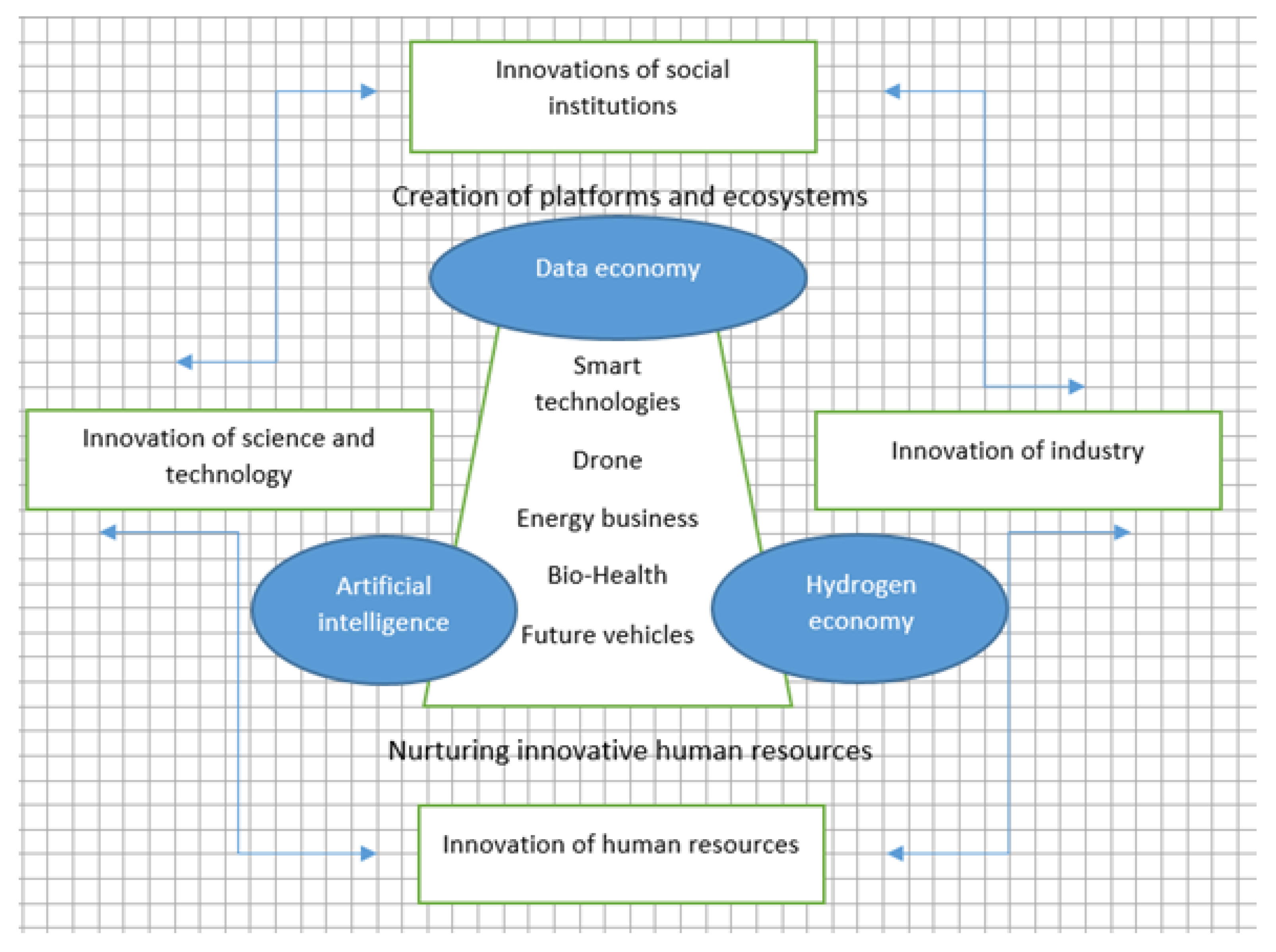
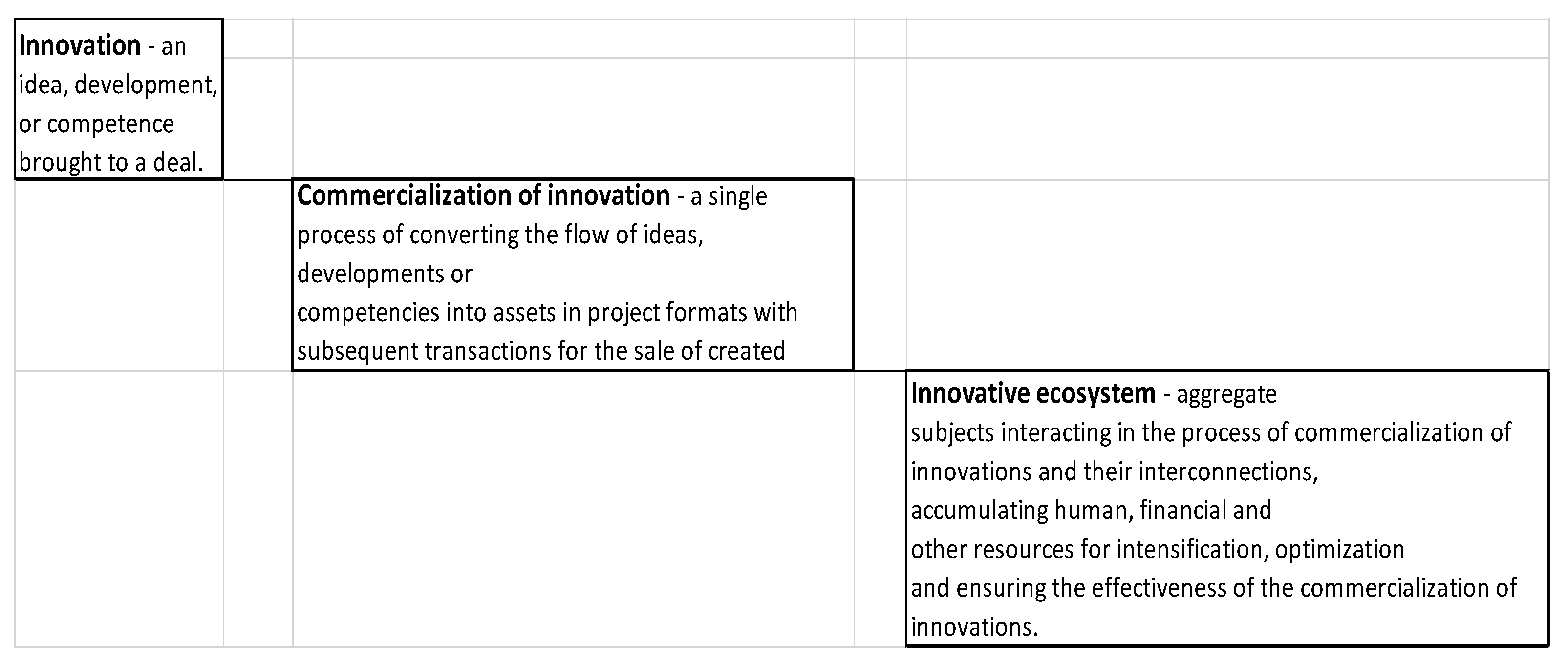
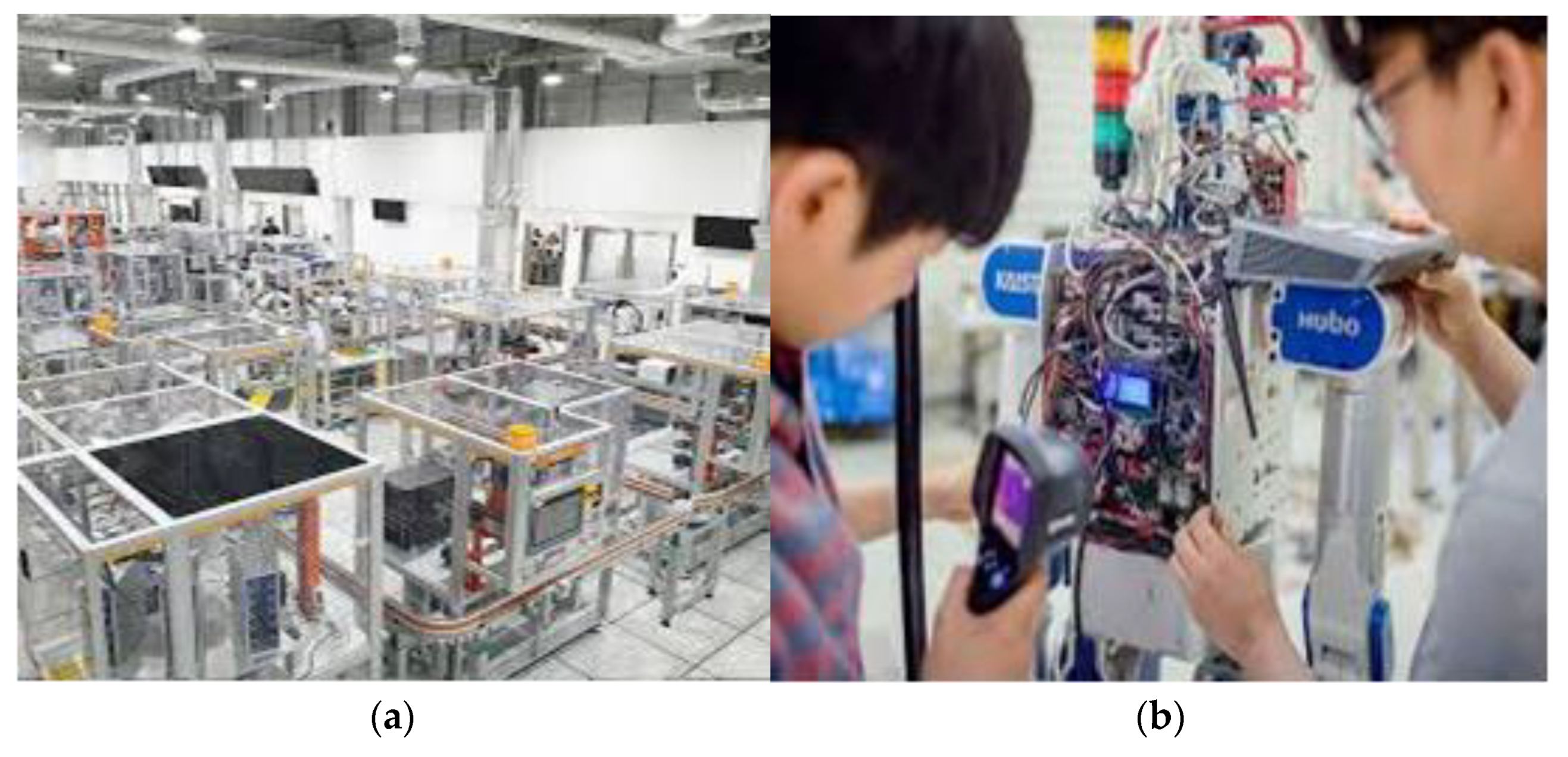
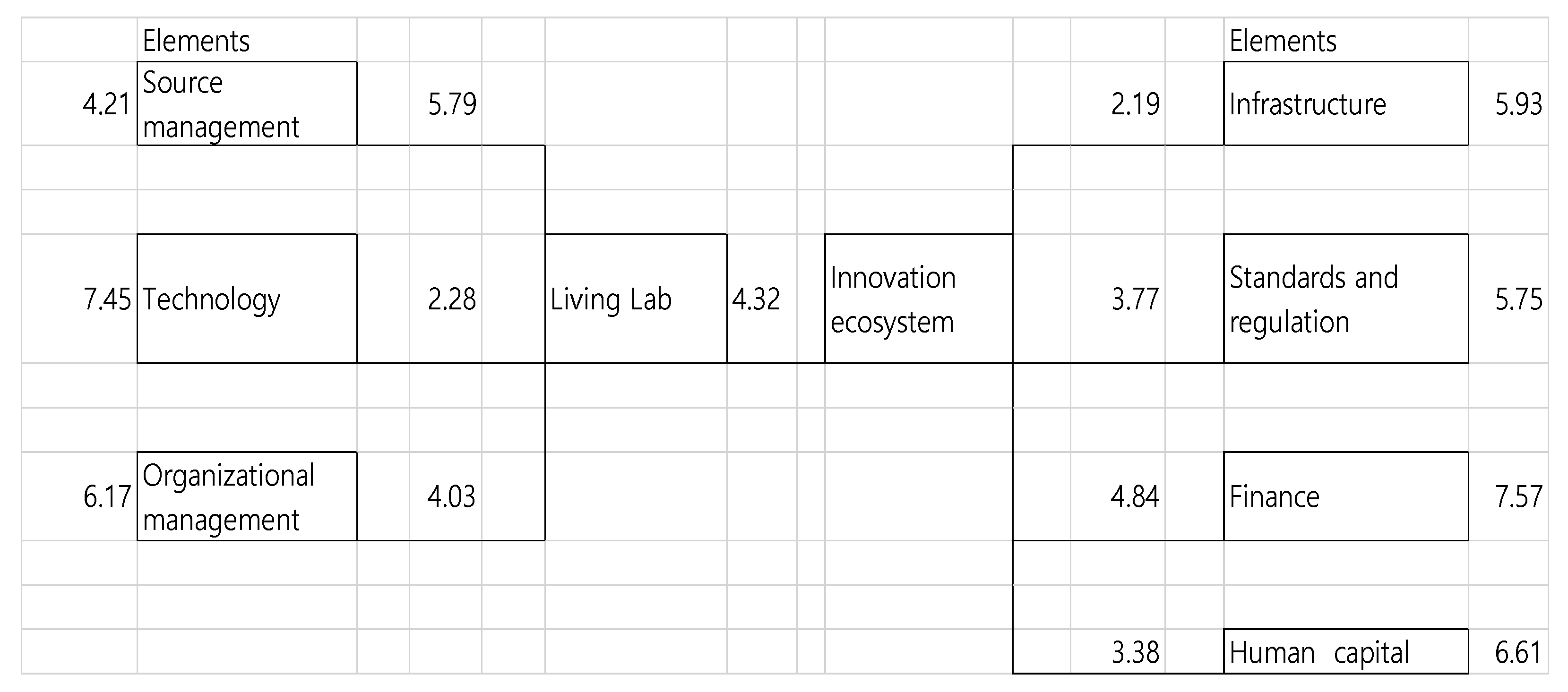
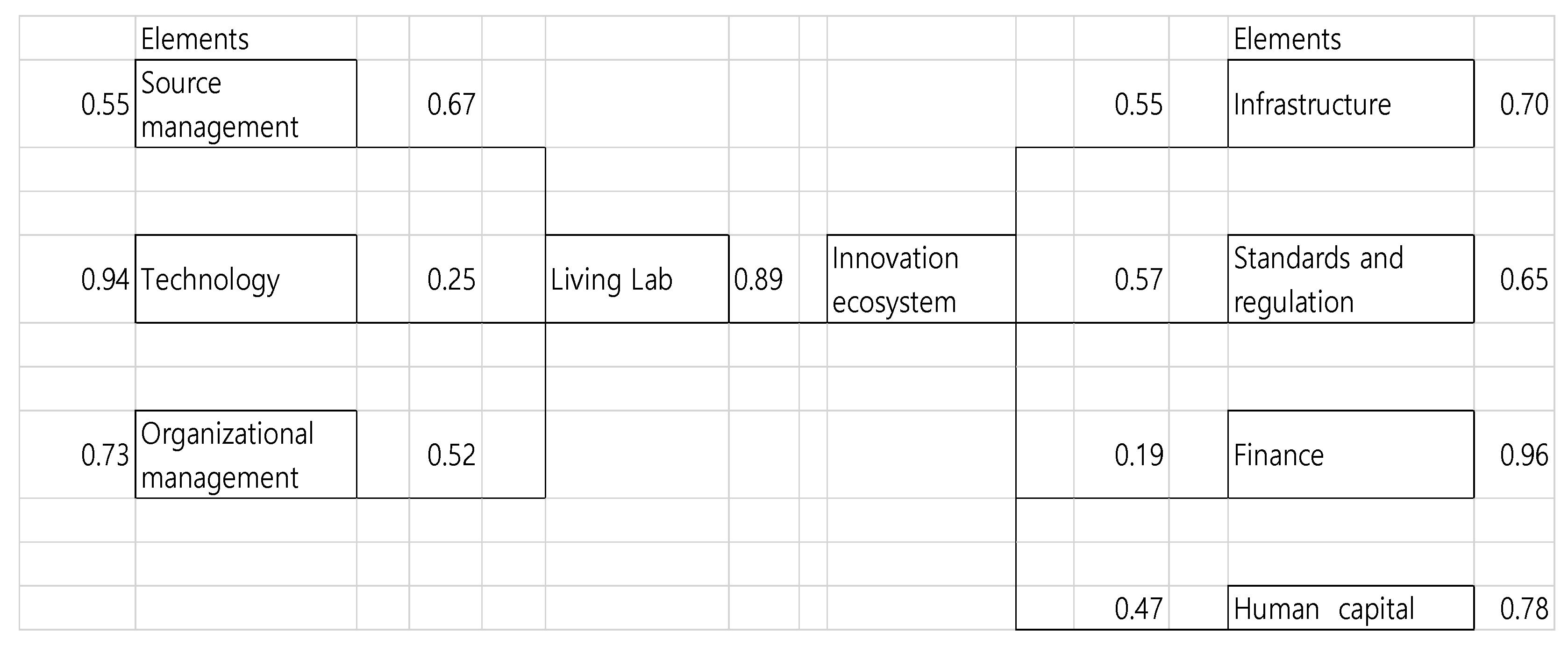
| Area of Investigation (Element of Innovation Ecosystem) | Benefits | Risks | Examples | Role of LL |
|---|---|---|---|---|
| Infrastructure | Cost reduction, specialization, concentration | Less control, dependence on facility’s owner | Benefit: Specialization and concentration on project’s task; possible to reduce costs due to local placement Risk: Not every partner will arrange control over the project; strong dependence on owner of infrastructure (lab, factory) | Development |
| Innovation transfer | Rapid growth and delivery of innovations | Competition, quality of service/product | Benefit: Creation of innovations may lead industry and university to new forms and methods of production and technology development, which can be more flexible and market-oriented. Partners may invent new strategies for franchising or licensing. Fewer entry barriers for new start-ups and small enterprises Risk: New innovations should be focused on market needs and industry standards, otherwise they will not be successful. Innovations should provide relevant quality of product/service | IP |
| Competence development | Knowledge, skills, and talent development | Competence assessment; matching industry’s/university’s standards | Benefit: Relevant competencies create new standards and skills, and new methods of start-up development are formulated; they help to implement competitive strategies for commercialization Risk: Competence model has some limitations: it must follow innovative system requirements; it should provide relevant impact for project’s developers and promoters | Training |
| Knowledge protection | Cooperation and brand expansion | Risks related to intellectual property and rights | Benefit: Participants may expand brand and improve positioning strategy Risk: Most start-ups enter fast-cycle markets, so competition may rise very fast; it is necessary to protect know-how and innovations and arrange intellectual property rights within collaboration | IP |
| Customization | New customers and profit; market expansion | Unstable market preferences (risk of customization); threats to health | Benefit: University expands strategy (even global), finds new markets, becomes more attractive to new customers Risk: Customer preferences are changeable, especially in different markets, so it is necessary to provide differentiation strategy | Promotion |
| Living Lab Set-Up Phase | Components of Living Lab | Role in Innovation Ecosystem | Participants/Stakeholders |
|---|---|---|---|
| Formation of community of developers | ICT + infrastructure | Cooperation | Business/academia/research centers |
| Formation of stakeholders | Partners | Resources | Government organizations |
| Formation of community of professionals and experts | Partners + users | Collaboration | Research and consulting centers/government organizations/academia/business |
| Formation of community of users (customers and providers) | Users + research | Market development | Business |
| Organization design | Methodology | Control | Business/academia/government |
| IT platform implementation | Innovations | Knowledge + data transfer | Research centers/academia |
| Living lab model development | Users + management | Innovation extension | Business/academia |
| Authors | Paper Title | Area of Investigation | Contribution in Literature | Recognized Problem (or Research Question) |
|---|---|---|---|---|
| Han J. and Kim K. (2015) | Enhancing Innovation Platform: Bitgaram Innocity Gwangju Using ICT in Korea | Innovation Lab, Incubation center and Smart City | Self-sufficiently leading process for the regional development, knowledge production and innovation through networking among the heterogeneous actors; presenting Living Lab model as a platform for communication using ICT for the construction of Energy Valley | Proposes-using business incubation centers as the core of the platform to understand whether various innovation activities can be spontaneously generated. |
| Cho E. (2018) | Transforming a Neighborhood into a Living Laboratory for Ur-ban Social Innovation: A Comparative Case Study of Urban Living Labs | Living Lab for Social innovation | Foster urban innovations by bringing various stakeholders, ranging from local governments to citizens, together to co-create innovation | What are the ways Urban Living Labs operate and contribute to fostering urban social innovation? |
| Kim Y., Lee H., Lee M.-K., Lee H., Jang H. (2020) | Development of a Living Lab for a Mobile-Based Health Program for Korean-Chinese Working Women in South Korea: Mixed Methods Study | Living lab in Health care industry | Develop a living lab for a mobile-based health (LL Health) program focused on improving the physical activity and cultural adaptation of female workers. | How do the cultural aspects and lifestyles of women are accommodated in the entire process of LL program development? |
| Kim J., Moon I. (2020) | A Study on Smart Factory Construction Method for Efficient Production Management in Sewing Industry | Living Lab in manufacturing process | Implication of Living Lab on production process | Which elements of Living Lab have strong impact on production capacity and quality system? |
| LL Element | Expert Group 1 (Project Managers) | Expert Group 2 (University) | Expert Group 3 (Industry/Company Representative Person) | Average Weight of Competence/Rank |
|---|---|---|---|---|
| Creating and acquiring start-up | 4 1 | 3 | 4 | 3.66/7 |
| Storing ideas/sources/knowledge | 4 | 5 | 5 | 4.66/1 |
| Developing start-ups (including support) | 4 | 5 | 3 | 4.0/6 |
| Challenging practice | 4 | 4 | 5 | 4.33/5 |
| Collaboration | 5 | 4 | 4 | 4.33/3 |
| Human capital | 1 | 1 | 1 | 1.0/10 |
| Structural (organizational, managerial) capital | 4 | 3 | 4 | 3.66/8 |
| Infrastructure development | 1 | 1 | 1 | 1.0/11 |
| Sharing technology | 5 | 4 | 5 | 4.66/2 |
| Communication capital (partnership) within industry-university cooperation | 4 | 5 | 4 | 4.33/4 |
| Civic consciousness | 1 | 2 | 1 | 1.33/9 |
| LL Element | New Weight/Rank (Transferred from Previous Table) = a | IE Development = Collaboration = b1 | IE Development = Infrastructure = b2 | IE Development = Start-Up = b3 |
|---|---|---|---|---|
| Storing ideas/sources/knowledge | 4.66 = a1 | 5 1 | 6 | 3 |
| Sharing technology | 4.66 = a2 | 7 | 3 | 5 |
| Collaboration | 4.33 = a3 | 4 | 3 | 3 |
| Communication capital (partnership) within industry-university cooperation | 4.33 = a4 | 6 | 4 | 7 |
| Challenging practice | 4.33 = a5 | 6 | 5 | 6 |
| Developing start-ups (including support) | 4.0 = a6 | 3 | 4 | 2 |
| Creating and acquiring start-up | 3.66 = a7 | 3 | 6 | 4 |
| Structural (organizational, managerial) capital | 3.66 = a8 | 6 | 6 | 5 |
| Weight of LL element (W)/Rank 2 | 170.14 | 153.82 | 147.5 |
| Indexes | Allowable Amount | Gained Numbers | Results |
|---|---|---|---|
| Proportion of Chi-square to freedom degree | X2/df < 3 | 2.67 | Suitable fitting |
| Pi value | p < 0.05 | 0.0005 | Suitable fitting |
| Root mean square of approximate error (RMSEA) | 0.05 < RMSEA < 0.08 | 0.039 | Suitable fitting |
| Hypothesis (H) and Research Questions (RQs) | Path | Step of Research, Where This Path Is Checked | Result |
|---|---|---|---|
| H | Living lab has a significant and positive impact on management decisions in innovation ecosystem | Based on the results from Table 5 we can see, that LL elements have the strongest impact on the first area of innovation ecosystem development (=development trough collaboration) within industry-university cooperation, because it has the highest rank. | Confirmed |
| RQ 1 | Could innovation system be developed with living laboratories? | From this expert method we find that the most important LL elements for Korean market are: creating, developing and acquiring start-up; storing knowledge and ideas; challenging practice through collaboration; structural and communication capital (university-industry cooperation); sharing technology. All of these competencies have average weight more than 3, 5 grades (Table 4). | Confirmed |
| RQ 2 | Does university–industry cooperation improve innovation ecosystem using living labs? | Based on interview process results, mentioned in Appendix A, the most important 11 LL elements are investigated during first step of the interview process. They are: creating, developing and acquiring start-up; storing knowledge and ideas; challenging practice through collaboration; structural and communication capital (university-industry cooperation); sharing technology; infrastructure development; civic consciousness; human capital. 30 experts from different groups evaluate the importance level of Living lab elements (minimum grade-less important, 5–maximum grade-the most important) and create the ranking list of them. | Confirmed |
| RQ 3 | Do living laboratories focus on start-up project development? | Based on interview process results, mentioned in Appendix A, the most important 11 LL elements are investigated during first step of the interview process. They are: creating, developing and acquiring start-up; storing knowledge and ideas; challenging practice through collaboration; structural and communication capital (university-industry cooperation); sharing technology; infrastructure development; civic consciousness; human capital. 30 experts from different groups evaluate the importance level of Living lab elements (minimum grade-less important, 5–maximum grade-the most important) and create the ranking list of them. | Confirmed |
| Category | Bukchon Living Lab | Seong-Daegol Living Lab | Geonneoyu Project | Korea University Living Lab |
|---|---|---|---|---|
| Project background and regional issue | Commercialization of IoT technology -Introduction of Living Lab as a means of investigate and solve issues in cities | Consciousness of crisis was raised due to Fukushima Daiichi nuclear disaster and blackout crisis Civic consciousness has been raised about energy conversion | Expansion of user participation in process of innovating scientific technology Increased demand on solving everyday life-related problems | Expansion of Industry-University cooperation in process of innovating scientific technology Increased demand on solving everyday life-related problems |
| Project Objective | Solving issues of city with IoT and promote convenience of tourists | Finding technological alternative for self-sufficient energy and related experiments | Solution of residents’ discomfort and enhanced convenience by using steeping stones | Solution of high-tech products market implementation |
| Governance Infrastructure | Government-provided infrastructure (Free access to Wi-fi network and public information) | Institutional, financial support for civil society-driven movement of energy conversion | Civil society finds the problem by itself and suggests an alternative | Government control system |
Publisher’s Note: MDPI stays neutral with regard to jurisdictional claims in published maps and institutional affiliations. |
© 2021 by the authors. Licensee MDPI, Basel, Switzerland. This article is an open access article distributed under the terms and conditions of the Creative Commons Attribution (CC BY) license (https://creativecommons.org/licenses/by/4.0/).
Share and Cite
Shvetsova, O.A.; Lee, S.-K. Living Labs in University-Industry Cooperation as a Part of Innovation Ecosystem: Case Study of South Korea. Sustainability 2021, 13, 5793. https://doi.org/10.3390/su13115793
Shvetsova OA, Lee S-K. Living Labs in University-Industry Cooperation as a Part of Innovation Ecosystem: Case Study of South Korea. Sustainability. 2021; 13(11):5793. https://doi.org/10.3390/su13115793
Chicago/Turabian StyleShvetsova, Olga A., and Sang-Kon Lee. 2021. "Living Labs in University-Industry Cooperation as a Part of Innovation Ecosystem: Case Study of South Korea" Sustainability 13, no. 11: 5793. https://doi.org/10.3390/su13115793
APA StyleShvetsova, O. A., & Lee, S.-K. (2021). Living Labs in University-Industry Cooperation as a Part of Innovation Ecosystem: Case Study of South Korea. Sustainability, 13(11), 5793. https://doi.org/10.3390/su13115793






